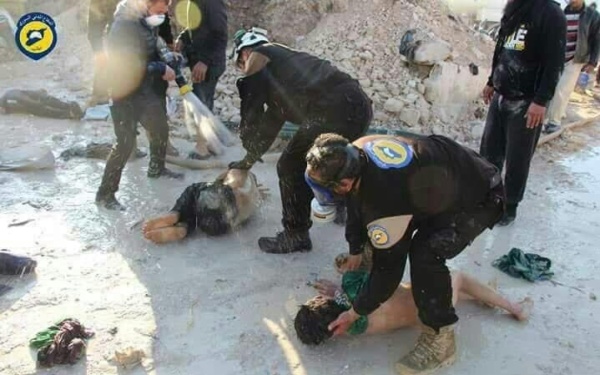White Helmets attend to victims of the Assad regime’s sarin attack on Khan Sheikhoun in northwest Syria, April 2017
As pro-Assad activists push a document trying to undermine inspectors of chemical attacks in Syria, Russia has introduced a UN Security Council resolution seeking to restrict the agency.
Moscow’s draft text says the Security Council is the only international body that can impose measures on countries which violate the Chemical Weapons Convention.
From 2015 to 2017 and again from June 2018, the Organisation for the Prohibition of Chemical Weapons has had a mechanism to identify the perpetrators of chemical attacks.
A Russian veto in the Security Council blocked that mandate in November 2017, after the OPCW found the Assad regime carried out a sarin attack in northwest Syria killing about 90 people and injuring hundreds.
But last year, the mandate was restored by the OPCW’s Conference of State Parties despite objections from Russia and the Assad regime.
See Syria Daily, Nov 15: Inspectors to Resume Assignment of Blame for Chemical Attacks
Moscow has long tried to restrict the OPCW with claims that it is manipulated by Western powers and its latest resolution declares”.the continuing politicization of the work of the OPCW and growing deviation from the established practice of taking consensus-based decisions”.
A diplomat noted, “What it’s really about of course is the Russians trying to strangle OPCW.”
The Douma Case
The Russian initiative follows a propaganda effort, through the “Working Group on Syria, Propaganda, and Media”, to discredit the OPCW’s final report on an April 2018 chemical attack.
Last week the Working Group, set up to support pro-Assad lines over issues such as chemical attacks, posted an engineering assessment that dissented from the OPCW’s report on the chlorine attack on Douma in the East Ghouta area near Damascus.
The OPCW found that a cylinder with chlorine lodged in a roof balcony, killing scores of people in the building. The attack came a day before rebels surrendered Douma, their last position in East Ghouta. More than 50,000 people were soon transferred to northern Syria.
The dissenting assessment came from Ian Henderson, a former OPCW inspection team leader who appears to be one of the experts consulted during the investigation. He circulated it two days before the OPCW’s final report, apparently as a dissent from the findings of the other experts and the Fact Finding Mission.
The Working Group built up the assessment as coming from “multiple sources” — rather than being the opinion of one individual — and used it for disinformation that the chlorine victims were actually bodies of people murdered by rebels and White Helmets rescuers in a “staged massacre”.

